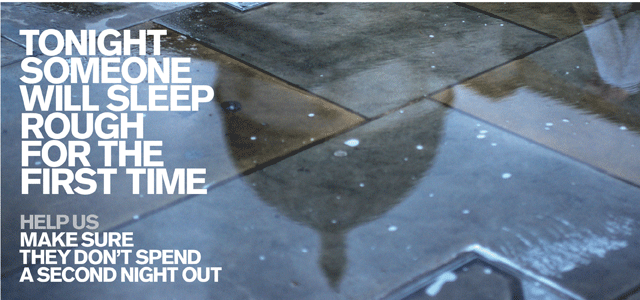
Established 2005 Registered Charity No. 1110656
Scottish Charity Register No. SC043760
DONATE
RECENT TWEETS
London mayor’s target to end homelessness by the end of 2012 has failed – but some progress is being made.
It was always an ambitious target, and one that many doubted was ever possible. With the economy in the toilet, it is perhaps even less surprising that it could not be achieved.
The Pavement has followed its progress since 2008, and although at points it looked as though it was within grasping distance, the various initiatives launched could not get to everyone.
According to CHAIN, 5,678 people slept rough at some point in London during 2011/12, an increase of 43 per cent on the previous year’s total of 3,975. But some initiatives, such as No Second Night Out, have seen success, with 60 per cent of people moving “into some form of accommodation”. NSNO director Petra Salva said this showed agencies were heading in the right direction, but argued services must redouble their efforts if they are ever to reach the target. “The number of people living on the street has hugely declined because of efforts of all agencies involved,” she told The Pavement. “Our commitment must not dwindle. If anything I think we need to double our efforts.”
Salva said work must focus “upstream”, preventing people from rough sleeping in the first place. Initiatives like NSNO must also work hard not to “create an incentive for people to come to the street to get a service,” she added. But the real challenge was the “patchy” responses from the multiagency approach across the city.
“A real issue for NSNO is that many agencies do not work to our time-frame and systems that exist take far too long,” she explained. “Challenges exist with speedy and timely access into PRS. It takes time to find housing and to set it up.
“Boroughs need coordinated services, good advice and prevention, local assessment beds etc,” Salva added. “Developing these locally will ensure we are more likely to achieve a higher success rate.”
Of course, NSNO has not been the only initiative aimed at reducing the number of people sleeping rough during the year of the Olympics and Jubilee.
Rough Sleeping 205 (RS205) is one of the London Delivery Board’s longer-term projects to reduce the number of “entrenched” rough sleepers. Set up in 2009, it now encompasses 349 people who are seen as needing particular focus to get off the streets.
Most recent figures from the Mayor’s Office show that the number has been reduced by around three-quarters, with only 78 of the individuals being seen rough sleeping in the last reporting period.
Acknowledging that the target had not been reached, a spokesperson for Boris Johnson’s office said the Mayor was “absolutely committed to ending rough sleeping” and would continue to work on the issue for “as long as it is necessary”.
“There has been considerable success in tackling rough sleeping in London,” the spokesperson added, highlighting the results of NSNO and RS205.
“NSNO will continue its groundbreaking work, complementing the initiatives of boroughs and other agencies who are the primary providers of services to rough sleepers in the capital.”
Outside London, the picture is arguably even worse. While authorities in the capital can claim to have kept a lid on the rise of homelessness, figures published by the Department for Communities and Local Government show the number of people classified as “priority homeless” has risen to 50,000 – 25% more than in 2009–10.
This has coincided with cuts to homeless services, meaning that just at the point when people need more help, less is on offer. As reported in last month’s issue, research agency SSentif has highlighted a direct correlation between the two factors – which managing director Judy Aldred described as “shocking”.
With the government announcing more austerity measures as part of the Autumn Statement at the start of this month, it seems that those services still aiming for an end to homelessness any time soon are being unrealistically optimistic.
June – July 2024 : Reflections
CONTENTS
BACK ISSUES
- Issue 150 : June – July 2024 : Reflections
- Issue 149 : April – May 2024 : Compassion
- Issue 148 : February – March 2024 : The little things
- Issue 147 : December 2023 – January 2024 : Next steps
- Issue 146 : October 2023 – November 2023 : Kind acts
- Issue 145 : August 2023 – September 2023 : Mental health
- Issue 144 : June 2023 – July 2023 : Community
- Issue 143 : April 2023 - May 2023 : Hope springs
- Issue 142 : February 2023 - March 2023 : New Beginnings
- Issue 141 : December 2022 - January 2023 : Winter Homeless
- Issue 140 : October - November 2022 : Resolve
- Issue 139 : August - September 2022 : Creativity
- Issue 138 : June - July 2022 : Practical advice
- Issue 137 : April - May 2022 : Connection
- Issue 136 : February - March 2022 : RESPECT
- Issue 135 : Dec 2021 - Jan 2022 : OPPORTUNITY
- Issue 134 : September-October 2021 : Losses and gains
- Issue 133 : July-August 2021 : Know Your Rights
- Issue 132 : May-June 2021 : Access to Healthcare
- Issue 131 : Mar-Apr 2021 : SOLUTIONS
- Issue 130 : Jan-Feb 2021 : CHANGE
- Issue 129 : Nov-Dec 2020 : UNBELIEVABLE
- Issue 128 : Sep-Oct 2020 : COPING
- Issue 127 : Jul-Aug 2020 : HOPE
- Issue 126 : Health & Wellbeing in a Crisis
- Issue 125 : Mar-Apr 2020 : MOVING ON
- Issue 124 : Jan-Feb 2020 : STREET FOOD
- Issue 123 : Nov-Dec 2019 : HOSTELS
- Issue 122 : Sep 2019 : DEATH ON THE STREETS
- Issue 121 : July-Aug 2019 : INVISIBLE YOUTH
- Issue 120 : May-June 2019 : RECOVERY
- Issue 119 : Mar-Apr 2019 : WELLBEING
- Issue 118 : Jan-Feb 2019 : WORKING HOMELESS
- Issue 117 : Nov-Dec 2018 : HER STORY
- Issue 116 : Sept-Oct 2018 : TOILET TALK
- Issue 115 : July-Aug 2018 : HIDDEN HOMELESS
- Issue 114 : May-Jun 2018 : REBUILD YOUR LIFE
- Issue 113 : Mar–Apr 2018 : REMEMBRANCE
- Issue 112 : Jan-Feb 2018
- Issue 111 : Nov-Dec 2017
- Issue 110 : Sept-Oct 2017
- Issue 109 : July-Aug 2017
- Issue 108 : Apr-May 2017
- Issue 107 : Feb-Mar 2017
- Issue 106 : Dec 2016 - Jan 2017
- Issue 105 : Oct-Nov 2016
- Issue 104 : Aug-Sept 2016
- Issue 103 : May-June 2016
- Issue 102 : Mar-Apr 2016
- Issue 101 : Jan-Feb 2016
- Issue 100 : Nov-Dec 2015
- Issue 99 : Sept-Oct 2015
- Issue 98 : July-Aug 2015
- Issue 97 : May-Jun 2015
- Issue 96 : April 2015 [Mini Issue]
- Issue 95 : March 2015
- Issue 94 : February 2015
- Issue 93 : December 2014
- Issue 92 : November 2014
- Issue 91 : October 2014
- Issue 90 : September 2014
- Issue 89 : July 2014
- Issue 88 : June 2014
- Issue 87 : May 2014
- Issue 86 : April 2014
- Issue 85 : March 2014
- Issue 84 : February 2014
- Issue 83 : December 2013
- Issue 82 : November 2013
- Issue 81 : October 2013
- Issue 80 : September 2013
- Issue 79 : June 2013
- Issue 78 : 78
- Issue 77 : 77
- Issue 76 : 76
- Issue 75 : 75
- Issue 74 : 74
- Issue 73 : 73
- Issue 72 : 72
- Issue 71 : 71
- Issue 70 : 70
- Issue 69 : 69
- Issue 68 : 68
- Issue 67 : 67
- Issue 66 : 66
- Issue 65 : 65
- Issue 64 : 64
- Issue 63 : 63
- Issue 62 : 62
- Issue 61 : 61
- Issue 60 : 60
- Issue 59 : 59
- Issue 58 : 58
- Issue 57 : 57
- Issue 56 : 56
- Issue 56 : 56
- Issue 55 : 55
- Issue 54 : 54
- Issue 53 : 53
- Issue 52 : 52
- Issue 51 : 51
- Issue 50 : 50
- Issue 49 : 49
- Issue 48 : 48
- Issue 47 : 47
- Issue 46 : 46
- Issue 45 : 45
- Issue 44 : 44
- Issue 43 : 43
- Issue 42 : 42
- Issue 5 : 05
- Issue 4 : 04
- Issue 2 : 02
- Issue 1 : 01
- Issue 41 : 41
- Issue 40 : 40
- Issue 39 : 39
- Issue 38 : 38
- Issue 37 : 37
- Issue 36 : 36
- Issue 35 : 35
- Issue 34 : 34
- Issue 33 : 33
- Issue 10 : 10
- Issue 9 : 09
- Issue 6 : 06
- Issue 3 : 03
- Issue 32 : 32
- Issue 31 : 31
- Issue 30 : 30
- Issue 29 : 29
- Issue 11 : 11
- Issue 12 : 12
- Issue 13 : 13
- Issue 14 : 14
- Issue 15 : 15
- Issue 16 : 16
- Issue 17 : 17
- Issue 18 : 18
- Issue 19 : 19
- Issue 20 : 20
- Issue 21 : 21
- Issue 22 : 22
- Issue 23 : 23
- Issue 24 : 24
- Issue 25 : 25
- Issue 8 : 08
- Issue 7 : 07
- Issue 26 : 26
- Issue 27 : 27
- Issue 28 : 28
- Issue 1 : 01

